
Ho Chi Minh Tourist Attractions – Ho Chi Minh City (Sai Gon) is the largest economic, political and cultural center in South Vietnam. Sai Gon – Ho Chi Minh City is also a major tourist center, with historical monuments and museums marking the war against France and the United States. The War Remnants Museum is referred as the most famous museum in Ho Chi Minh City. In addition, colonial buildings are also great attractions you must visit while touring Sai Gon, such as the City Hall, the Opera House, Central Post Office, Nha Rong Port, Ben Thanh Market, the Independent Palace. Recently, new modern buildings such as Diamond Plaza, Bitexco Financial Tower, Sai Gon Trade Center also beautify the city center. On the outskirts of the city, there are also attractions such as Cu Chi Tunnels, Can Gio Mangroves and Thu Duc Stork Garden.
Here are useful tips you should collect for your travel to Ho Chi Minh city, to explore the most famous attractions in the city.
Best time to visit Ho Chi Minh and explore all Ho Chi Minh Tourist Attractions?
Unlike Ha Noi, the weather in Sai Gon is divided into two distinct seasons: Dry season and rainy season. But the sun of Sai Gon is not too hot, the rain does not last too long. Therefore, you can travel to Sai Gon at any time of the year as this is a busy, vibrant city all year round to experience the city’s life, to explore famous tourist attractions in Ho Chi Minh.
How to get to Ho Chi Minh?
It is very easy to travel to Ho Chi Minh by different means of transport such as airplanes, trains or buses. It takes about 2 hours by airplane from Hanoi while train or bus takes about 30 to 35 hours.
Tan Son Nhat is the only airport in Ho Chi Minh, served for both domestic and international flights to/from many different countries. The airport is located close to the center. Therefore after arriving, you can easily take a taxi or bus to your hotel.
If you travel to Ho Chi Minh from Cambodia, you can also take a flight or bus via the land border at Tay Province, or cruise via the Mekong river.
While touring Ho Chi Minh tourist attractions you can go by taxi or city bus or rent a motorbike provided by many travel shops around Pham Ngu Lao street and Bui Vien street.
Below is the list of Ho Chi Minh Tourist Attractions that are highly recommended by Hanoi Tours Expert. You will visit the famous attractions in Ho Chi Minh city by booking Ho Chi Minh city tour with us.

Ho Chi Minh City Hall
Ho Chi Minh City Hall is officially known as the Ho Chi Minh City People’s Committee Building. It was first known as the Hotel de Ville when it was completed in 1908. Its French builders drew inspiration from town halls in Europe. The building was known as the City Hall of Saigon before 1975. Once the Communists took over, the building took on its present name.
Ho Chi Minh City Hall is closed to the public as it is an official Vietnamese government building. It is beautiful French Colonial architecture and sunny cream-and-yellow hue, along with its iconic statue of Ho Chi Minh, make it a tourist favorite and a symbol of Saigon. The building stands at one end of Nguyen Hue Boulevard on The Le Thanh Ton Street, a brisk walk away from Dong Khoi Street.
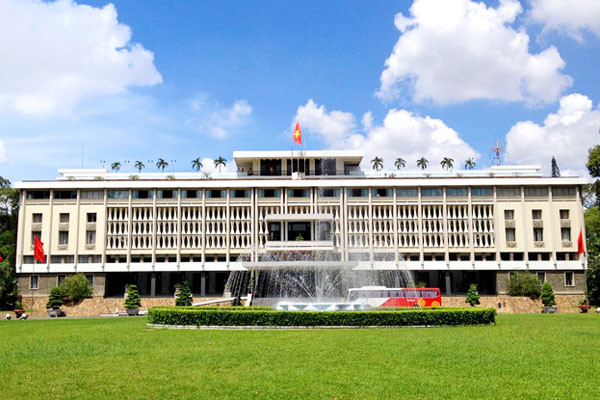
Reunification Palace, Ho Chi Minh city
Reunification Palace (the formerly Independence Royal Palace). Distinctly 1970s architecture and fine grounds make this at least worth a walk by. The iconic Vietnam War picture of a tank crushing its way through the iron gates of the palace on liberation day was taken here. It was designed by Ngo Viet Thu as the home and workplace of the President of South Vietnam during Vietnam War and the site of the official handover of power during the Fall of Saigon on April 30, 1975. It was then known as Independence Palace, and an NVA tank crashed through its gates, as recorded by Neil Davis.

Notre Dame Cathedral – Ho Chi Minh
Notre Dame Cathedral is a huge architectural monument located in the heart of Ho Chi Minh City. This red-brick structure with its twin towers has been a well-known feature of the nation’s economic capital.
Located right in the heart of Ho Chi Minh City is the most famous landmark as well as the core Cathedral of the city, Notre Dame Cathedral (meaning as Nhà thờ Đức Bà Sài Gòn).
Notre Dame Cathedral, or Notre-Dame Basilica to be exact, is a famous age-long cathedral in Southern Vietnam. It is a magnificent building located at the Paris Square in Ho Chi Minh City downtown, attracting not only Catholics but also most tourists for its neo-Romanesque style architecture and a sacred atmosphere.
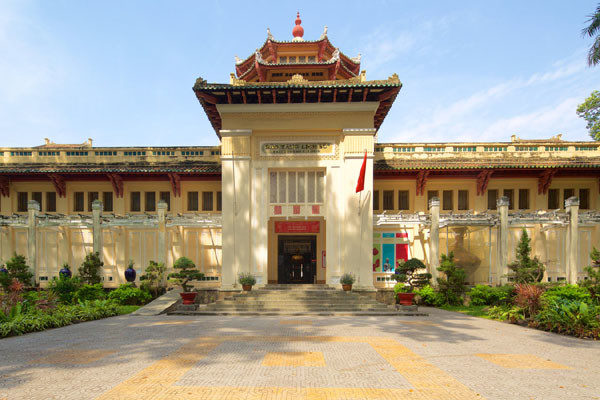
Museum of Vietnamese History – Ho Chi Minh
The Museum of Vietnamese History in Ho Chi Minh City was built in 1929 and was originally called the Blanchard de la Brosse Museum. In the span of years between 1929 and 1956, it mainly exhibited ancient art collections of a few Asian countries. The Museum was renamed Saigon National Museum after 1956 and was called so till 1975. Post 1975 the museum was expanded and has been called the Museum of Vietnamese History since then.

Ben Thanh Market – Ho Chi Minh
Ben Thanh Market is a large marketplace in the downtown area of Saigon in District 1. Ben Thanh Market is one of the earliest surviving structures in Saigon and is popular with tourists seeking local handicrafts, textiles, “ao dai’ and souvenirs, as well as local cuisines.
Ben Thanh Market was built in 1870 by the French, the market was called Les Halles Centrales before being renamed Ben Thanh in 1912. From a wet created by street vendors by the early 17th century, Ben Thanh market has experienced many ups and downs throughout its history and is the oldest surviving market and one of the symbols of Saigon. That makes it a must for any visitors to this 300-year-ole city.
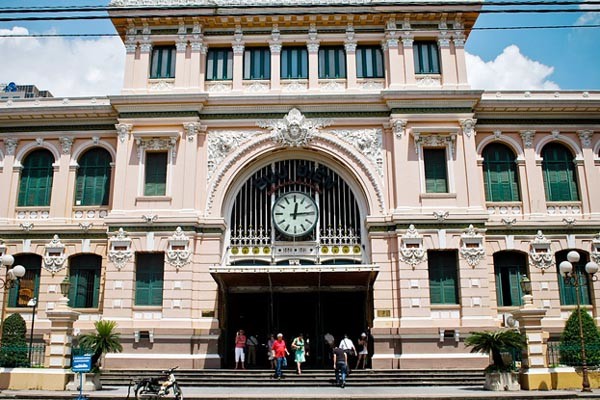
Saigon Central Post Office
Saigon Central Post Office was built in 1886 and till 1891 it was completed according to the design drawing of the architect Ville Dieu. The front of the building was decorated in rectangle cases on which the names of the inventors of telegram and electric professions. On the cases are the pictures of men and women wearing laurel wreaths. On the arc of the building, there is a huge clock. Entering inside, the tourists can have a look at two historical maps: Saigonet ses environs (1892) and Lignes Télégraphiques du Sud Vietnamnet du Cambodge (1936) along the two walls.
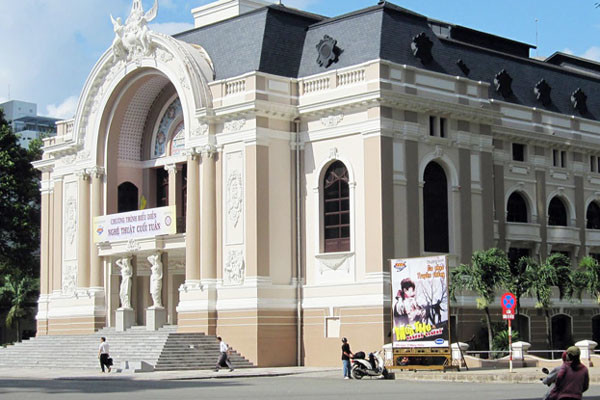
The Saigon Opera House
The Saigon Opera is an opera house in Saigon and it is an example of French Colonial architecture in Vietnam. It was built in 1897 by French architect Ferret Eugene as the Opera De Saigon, the 800 seat building was used as the home of the Lower House assembly of South Vietnam after 1956. It was not until 1975 that it was again used as a theatre, and restored in 1995.

War Remnants Museum – Ho Chi Minh
War Remnants Museum – Operated by the Vietnamese government, an incipient form of the museum opened on September 4, 1975, as the “Exhibition House for US and Puppet Crimes”, located in the premises of the former United States Information Agency building. The exhibition was not the first of its kind for the North Vietnamese side, but rather followed a tradition of such exhibitions exposing “war crimes”, first those of the French and then those of the Americans, who had operated at various locations of the country as early as 1954.
In 1990, the name changed to Exhibition House for Crimes of War and Aggression. In 1995, following the normalization of diplomatic relations with the United States and end of the US embargo from a year before, the references to “war crimes” and “aggression” were dropped from the museum’s title as well; it became the “War Remnants Museum”.
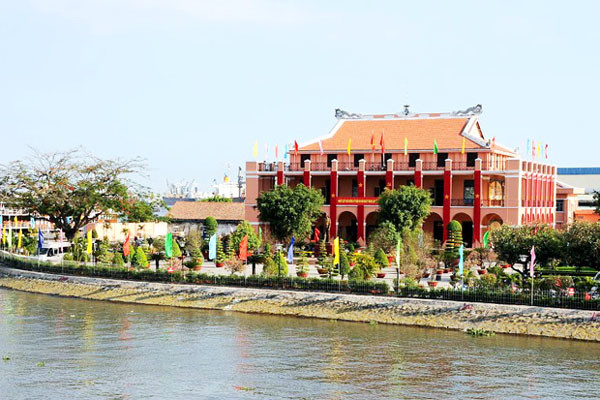
Nha Rong Wharf – Ho Chi Minh
Nha Rong Wharf is located at the junction of the Ben Nghe Channel and the Saigon River. And Nha Rong Wharf is a cultural site with special relics in Ho Chi Minh City, where late President Ho Chi Minh left to seek ways to save the nation.
On 5 June 1911, the patriotic young man Nguyen Tat Thanh left the country on the ship, Admiral Latouche Treville, to begin his quest for salvation. Many changes have taken place over the past 100 years but Nha Rong Wharf still exists and the ideals of the young man who later became the great leader of Vietnam are still shining along with the nation. Nha Rong Wharf was built in 1863 by French colonialists. The building was a combination of western and eastern architecture and has two dragons “dragons flanking the moon” so often referred to as “The Dragon” and the port is also called Nha Rong Wharf.

Cu Chi Tunnels, Ho Chi Minh City
Cu Chi Tunnels – The town of Cu Chi is a district of greater Ho Chi Minh City and has a population of about 200, 000 (it had about 80, 000 residents during the American War). At first glance, there is little evidence here to indicate the intense fighting, bombing and destruction that occurred in Cu Chi during the war.
Cu Chi Tunnels network became legendary during the 1960s for its role in facilitating Vietnamese troop control of a large rural area only 30km to 40km from Ho Chi Minh City. At its height the tunnel system stretched from the South Vietnamese capital to the Cambodian border, in the district of Cu Chi alone there was more than 250km of tunnels. The network, parts of which was several storeys deep, included innumerable trap doors, constructed living areas, storage facilities, weapons factories, field hospitals, command centers and kitchens.
If you have a story to share or a question that has not been answered on our website, please contact us to get in touch with us via the contact details listed below:
- Address: Ho Guom Plaza Building, 102 Tran Phu Road, Ha Dong Dist, Hanoi city, Vietnam.
- Phone: +84 961738229
- Hotline: +84 975558866 (24/7/365 – Whatsapp/Viber/Line)
- Email: [email protected]
- Skype: hanoitoursexpert
- Facebook: https://www.facebook.com/hanoitoursexpert

